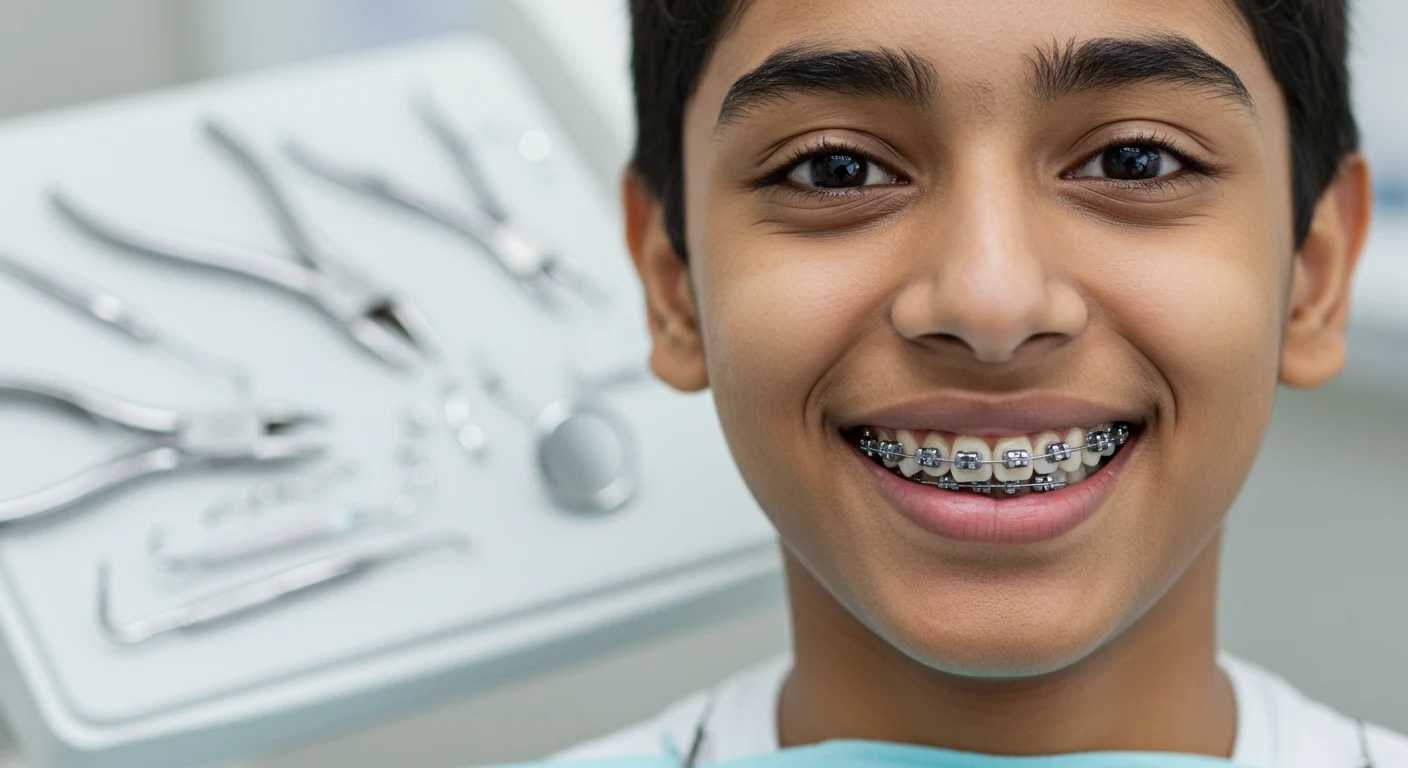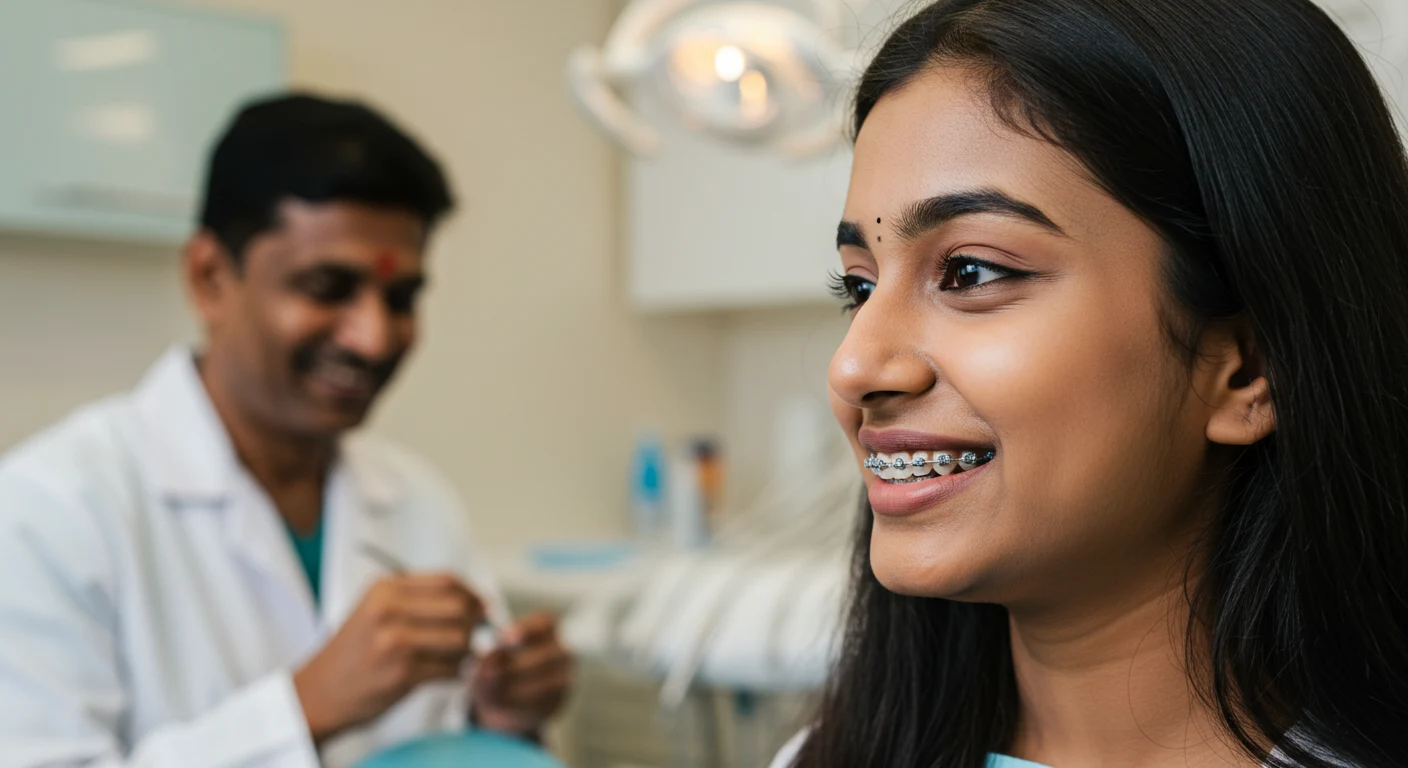The Complete Guide to Braces Maintenance

Braces don't just straighten your teeth; they reshape your daily habits. From brushing techniques to food choices, everything gets a small adjustment. And yes, some days it can feel like you've signed up for an extra job in your mouth.
But here's the good part: With the right routine, it becomes manageable. Even second nature.
Whether you're a teen building a confident smile or a parent helping your child through treatment, knowing what to do (and what to avoid) makes all the difference. Gums and Braces you through every step, so your journey is smooth, clean, and complication-free.
Let's start with the basics that make the biggest impact: cleaning.
How to Clean Braces Like a Pro
Cleaning with braces takes more than a quick swipe of your toothbrush. Brackets, wires, and tight spaces collect food and plaque quickly, and sloppy cleaning can lead to stained enamel, swollen gums, or even delayed progress.
Brushing After Every Meal
This one's non-negotiable. After every meal, brush with a soft-bristled toothbrush or an electric one fitted with an orthodontic head. Focus on:
- Brackets and wires: Use gentle, circular strokes.
- Angles: Tilt your brush at 45° to get under and around each bracket.
- Timing: Two full minutes. No shortcuts.
This keeps plaque in check and reduces the risk of stains or bad breath. If you're on the go, pack a travel kit, a small brush, toothpaste, and a mini mirror.
Pro Tip: Dr. Sneh Mehta recommends setting a brushing alarm on your phone for after-lunch cleanups, especially for students or professionals.
Flossing Without Losing Your Mind
Regular floss won't work with braces. You'll need a floss threader or orthodontic floss to weave the string behind the wires. It takes time but it clears out debris that brushing can't reach.
If manual flossing feels too complicated, try a water flosser. It sprays water between teeth and around brackets, it's perfect for sensitive gums treatment and late-night convenience.
Reminder: Flossing once a day, especially before bed, cuts down gum swelling and helps prevent bleeding.
Cleaning Tools That Help
Here's what patients at our clinic swear by:
- Interdental brushes: Tiny brushes that reach around brackets and between teeth. Ideal for post-snack touch-ups.
- Mouthwash: Choose an alcohol-free rinse to avoid drying out your mouth while keeping bacteria at bay.
- Orthodontic wax: A small roll pressed onto brackets that feel sharp or irritating.
- On-the-go kit: Toothbrush, mirror, wax, and floss packed into a pouch. Easy to carry, especially for students or travellers.
Dr. Tuhina Mehta encourages every patient to build this mini cleaning kit and carry it daily. It prevents minor issues from turning into clinic visits.
Eating With Braces: Foods to Skip, Foods to Love
Your braces may be doing the heavy lifting, but what you eat (and how you eat it) can either help or sabotage the whole process.
A careless snack can pop a bracket. A hard bite can bend a wire. And sugary foods? They love clinging to places your toothbrush struggles to reach. That doesn’t mean you need to live off mush. You just need to be smart about it.
What to Avoid (Unless You Enjoy Emergency Visits)
Here's a short list of troublemakers our team has seen ruin progress more times than we'd like:
- Hard foods: Popcorn, chikki, peanut brittle, hard toast, crusty pizza.
- Sticky snacks: Chewing gum, toffees, ladoos with nuts, caramel anything.
- Crunchy chips: Kurkure, nachos, thick potato chips that wedge into brackets.
- Sugary snacks: Cakes and sweets that stick around longer than they should.
These can break brackets, cause swelling, or stain the enamel around the braces. If a food feels like a risk even without braces, it's not a good idea now.
One rule that works: If you have to pull, chew hard, or suck it off your teeth, skip it.
Braces-Safe Foods That Don't Feel Like a Punishment
The good news? There's a long list of braces-friendly foods that taste good and feel easy to chew, even after a tigh
Soft meals you can rely on:
- Dal-chawal
- Curd rice
- Idlis or soft theplas
- Khichdi
Snacks that won't sabotage your progress:
- Yogurt or flavoured curd
- Paneer cubes
- Smoothies (banana + milk + soft fruits like dates or mango pulp)
- Boiled eggs, upma, and poha
Keep things simple and low on crunch. If you're packing lunch, throw in a spoon and skip the dry snacks.
Smart move: After your ortho appointment, prep 2-3 days of soft meals in advance, you'll thank yourself.
How to Eat Without Wrecking Your Brackets
What you eat matters. But how do you eat it? That's often the real game changer.
- Slice everything: Apples, crunchy veggies, and toast, cut them into small pieces.
- Chew from the sides: Avoid biting directly with your front teeth.
- Take smaller bites: This reduces pressure on brackets and makes chewing easier.
- Eat slowly: You'll spot trouble textures before they cause damage.
At Gums and Braces, we often show patients (especially kids) how to angle their bites and break food down into smaller, safer portions. It becomes second nature after a few weeks.
Bonus tip: Maintain a weekly meal plan. It's one of the easiest ways to stay consistent and avoid last-minute snack mistakes.
Handling Discomfort Without Losing Your Mind
Soreness with braces? Completely normal. Especially in the first few days or after adjustment visits. Think of it as your teeth reacting to movement, not damage.
Most discomfort is short-lived, and the right strategies can make a big difference.
Why Braces Cause Discomfort
Pressure after adjustments: Tightening the wires puts gentle but steady pressure on your teeth.
Rubbing brackets: New brackets may irritate your cheeks, lips, or tongue.
Wire pokes: Occasionally, a wire shifts or extends too far and starts jabbing.
These sensations often peak within the first 48 hours and ease up naturally as your mouth adapts.
Note: Pain that feels sharp, constant, or worsens over time? That’s worth flagging during your next appointment.
Simple Remedies That Actually Work
You don't need a full pharmacy to feel better, just a few tried-and-tested tools:
- Warm saltwater rinse: Half a teaspoon of salt in a glass of warm water. Rinse 2–3 times a day to soothe ulcers or swelling.
- Cold compress: Apply it on the outside of your cheek to numb soreness.
- Orthodontic wax: Roll a small ball and press it over any bracket or wire causing friction.
- Pain relief: Paracetamol in safe doses works well for post-adjustment discomfort. Avoid aspirin, as it may increase bleeding.
At Gums and Braces, we show every patient how to apply wax and identify when over-the-counter relief makes sense. A few small tools and habits go a long way.
Helpful tip: Keep salt packets, wax, and a mini mirror in your braces pouch, especially during your first month of treatment.
Orthodontic Appointments: Why They Matter More Than You Think
Skipping your check-up isn't just about delaying a visit; it throws off your entire treatment plan. Regular appointments are where progress happens, problems get caught early, and your timeline stays on track.
What Happens During an Adjustment
Each appointment typically takes 20–30 minutes and follows a simple structure:
- Removal of old elastic bands or ligatures
- Tightening or replacing wires to continue movement
- Checking bracket alignment
- Updating your progress chart
You might feel a bit of pressure for a day or two afterwards; that's normal. Soft meals and a little extra wax help ease the transition.
How to Communicate With Your Orthodontist
We love it when patients tell us exactly what's happening:
- Got a poking wire?
- A bracket that feels loose?
- Pressure that feels stronger on one side?
Speak up. It saves time, avoids discomfort, and helps us adjust our care in real time.
Bonus: Our clinic creates custom follow-up schedules based on your specific case. Some patients visit every 4 weeks, others slightly more or less.
Braces Problems Happen & How to Handle Them
Even with perfect habits, braces come with surprises. Wires shift. Brackets loosen. Food stains sneak in. The good news? Most of these are easy to fix or manage at home until your next appointment.
Everyday Issues and What Causes Them
You're not alone. These are some of the most common braces problems we see:
- Broken brackets: Often caused by biting into something too hard or sticky.
- Poking wires: May happen after adjustments or from accidental pressure.
- Discolouration: Usually due to missed brushing or stain-heavy foods.
- Gum swelling: Often linked to poor brushing technique or plaque buildup.
We also catch a lot of sneaky habits, chewing pens, fingernails, or biting bottle caps. These little habits wear down wires over time and undo progress.
Our tip: Set small visual cues around the house for kids and teens, post-it notes, lunchbox reminders, or mirror stickers to gently stop bad habits before they start.
Preventing Long-Term Damage
The goal isn't just short-term comfort, it's long-term success. That means:
- Don't chew ice, pens, or fingernails
- Brush properly after every meal
- Rinse after snacks if brushing isn't possible
- Stick to soft foods after each adjustment
At Gums and Braces, we teach every patient to spot early signs of damage and avoid them entirely. Because no one wants extra weeks added to their treatment timeline.
Reminder: Prevention beats panic. A 5-minute fix today can save a 2-week delay tomorrow.
Braces Make You Beam, But It's the Little Things That Keep the Smile Going
Braces don't just change your teeth replacement, they reshape your daily routine. And while the journey can feel like a grind some days, the small, consistent actions make all the difference.
A few extra minutes spent brushing, choosing the right snacks, or applying orthodontic wax can save you weeks of delays later. You don't need perfection, just consistency.
At Gums and Braces Dental Clinic, we support you through every step of this process. Whether it's fine-tuning your brushing, helping you deal with discomfort, or adjusting your treatment as your smile evolves, we're here to keep things moving forward.
Want a smoother braces journey? Book your visit today today and let's keep your smile on track together.
Frequently Asked Questions
How often should I brush my teeth with braces?
Ideally, after every meal. At minimum, twice a day (morning and night) with a soft-bristled or orthodontic toothbrush.
Is flossing with braces really necessary?
Yes. Braces trap food between teeth. Flossing (using a threader or water flosser) removes what brushing can't.
Can I eat chocolate or sweets with braces?
You can occasionally. But avoid sticky types like caramel or toffees, and always rinse or brush afterwards.
What should I do if a wire pokes or breaks?
Use orthodontic wax to cover the sharp edges, and call your orthodontist. If needed, gently reposition the wire with clean tweezers.
Do I need special toothpaste or mouthwash for braces?
Not necessarily. Fluoride toothpaste and alcohol-free mouthwash are ideal. Look for products labelled "brace-friendly" for added comfort.

